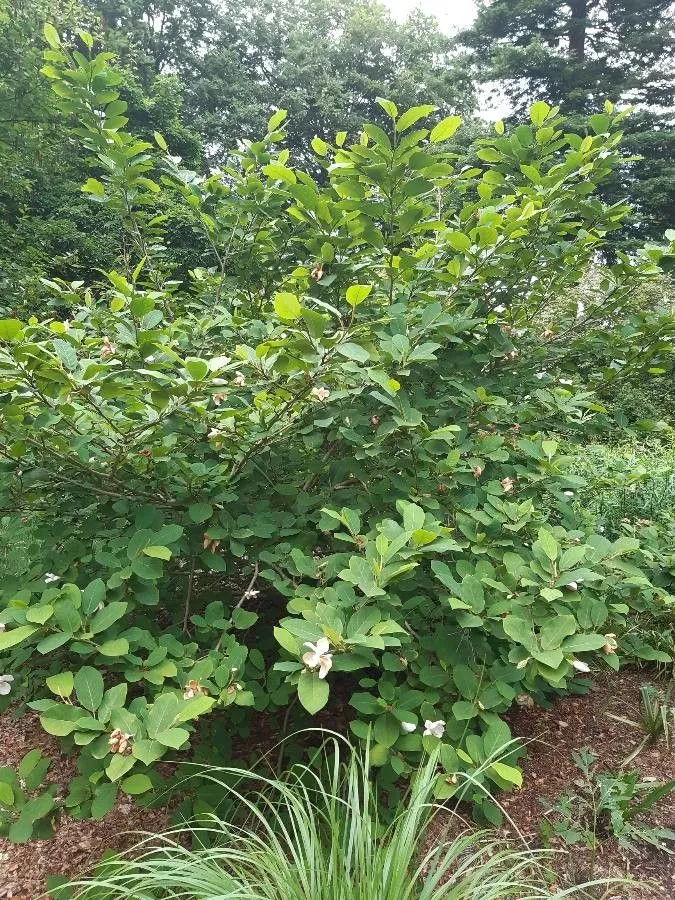
Author: K.Koch
Bibliography: Hort. dendrol. 4, No. 11. 1853
Year: 1853
Status: accepted
Rank: species
Genus: Magnolia
Vegetable: False
Observations: C. China to Japan
Oyama magnolia, scientifically known as Magnolia sieboldii, is a captivating deciduous shrub or small tree that belongs to the Magnoliaceae family. It is renowned for its graceful beauty and ethereal charm. This elegant plant is native to regions extending from central China to Japan, thriving in the temperate climates of East Asia.
First described in 1853 by the botanist K. Koch in “Hort. dendrol.”, the Oyama magnolia has captivated the interest of horticulturists and plant enthusiasts alike. What makes this magnolia distinctive are its exquisite flowers, which bloom from late spring to early summer. The blossoms are a pristine white, sometimes tinged with hints of pink, and possess a delightful cup-shaped form. Moreover, the flowers often reveal a contrasting bright red to yellow center, accentuated by a cluster of protruding stamens, making them a striking sight.
Unlike many other magnolia species, Magnolia sieboldii prefers a shaded to semi-shaded environment, making it an excellent understory plant. Its leaves are broad, dark green, and slightly leathery, providing a robust backdrop that highlights its delicate flowers. The foliage, coupled with its gently arching branches, creates a lush and refined appearance, even when the plant is not in bloom.
The Oyama magnolia is also noted for its hardiness, particularly in cooler climates, which extends its growing range beyond that of some other magnolias. This resilience, coupled with its modest size, makes it an ideal choice for gardens, parks, and even larger containers.
In summary, Magnolia sieboldii, or Oyama magnolia, is a delightful ornamental plant that brings a touch of elegance and charm to any landscape. Its lovely, fragrant flowers and handsome foliage make it a coveted addition for those seeking to enhance their gardens with a piece of botanical artistry.
Eng: oyama magnolia
Swe: buskmagnolia
Nno: junimagnolia
Nob: junimagnolia
En: Oyama magnolia, Siebold’s Magnolia
Fr: Magnolia de Siebold
De: Siebolds Magnolie
Nb: Junimagnolia
Nn: Junimagnolia
Sv: Buskmagnolia
Taken May 30, 2022 by Miles Penk (cc-by-sa)
Taken Jun 8, 2021 by Reiser Frank (cc-by-sa)
Taken Mar 21, 2022 by lauren Powell (cc-by-sa)
Taken Jun 12, 2021 by Dieter Albrecht (cc-by-sa)
Taken May 29, 2020 by Exner Sebastian (cc-by-sa)
© copyright of the Board of Trustees of the Royal Botanic Gardens, Kew.
© copyright of the Board of Trustees of the Royal Botanic Gardens, Kew.
© copyright of the Board of Trustees of the Royal Botanic Gardens, Kew.
Taken May 18, 2022 by Philippe de Spoelberch (cc-by-sa)
Taken Jul 20, 2021 by Giode Tonpino (cc-by-sa)
Taken Jun 28, 2021 by Philippe de Spoelberch (cc-by-sa)
Taken May 26, 2022 by William Coville (cc-by-sa)
Taken May 28, 2021 by Denis Alkan (cc-by-sa)
Taken May 28, 2021 by Denis Alkan (cc-by-sa)
Taken Apr 17, 2022 by Maarten Vanhove (cc-by-sa)
Taken Oct 9, 2022 by Andreas Schmid (cc-by-sa)
Taken May 26, 2022 by William Coville (cc-by-sa)
Taken Sep 4, 2022 by Rainer H. David (cc-by-sa)
Taken Aug 4, 2022 by Elena Yukhatova (cc-by-sa)
Taken Jul 20, 2021 by Giode Tonpino (cc-by-sa)
Taken May 26, 2022 by William Coville (cc-by-sa)
Taken Jul 24, 2021 by Antonio López San Román (cc-by-sa)
Taken Sep 13, 2022 by janusz smoliwąs (cc-by-sa)
Taken Sep 15, 2022 by Brigitte Huber-Jordi (cc-by-sa)
Taken Sep 13, 2022 by janusz smoliwąs (cc-by-sa)
Taken Sep 10, 2022 by Lasse Sabell (cc-by-sa)
Taken Oct 9, 2011 by Tela Botanica − Philippe DEKERFAO (cc-by-sa)
Taken Jul 20, 2021 by Giode Tonpino (cc-by-sa)
Taken Jul 15, 2009 by Photoflora – Jean-Luc TASSET (©)
Growth habit>: Tree
Family: Myrtaceae Author: (F.Muell.) K.D.Hill & L.A.S.Johnson Bibliography: Telopea 6: 402 (1995) Year: 1995 Status:…
Family: Rubiaceae Author: Pierre ex A.Froehner Bibliography: Notizbl. Bot. Gart. Berlin-Dahlem 1: 237 (1897) Year:…
Family: Sapindaceae Author: Koidz. Bibliography: J. Coll. Sci. Imp. Univ. Tokyo 32(1): 38 (1911) Year:…
Family: Asteraceae Author: A.Gray Bibliography: Pacif. Railr. Rep.: 107 (1857) Year: 1857 Status: accepted Rank:…
Family: Fabaceae Author: Medik. Bibliography: Vorles. Churpfälz. Phys.-Ökon. Ges. 2: 398 (1787) Year: 1787 Status:…
Family: Aspleniaceae Author: (Cav.) Alston Bibliography: Bull. Misc. Inform. Kew 1932: 309 (1932) Year: 1932…